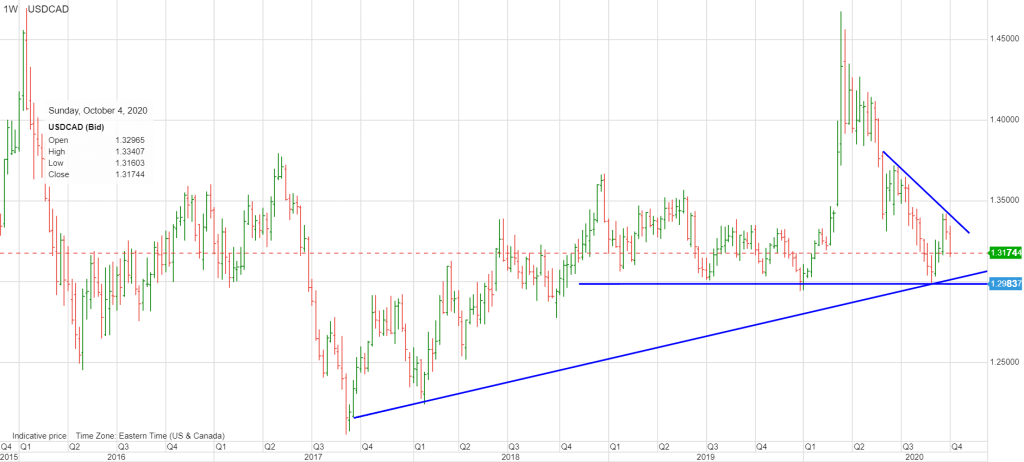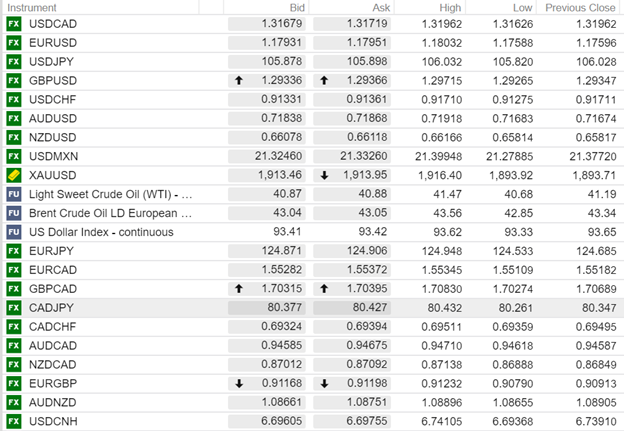
Photo: Wikimedia
October 9, 2020
USDCAD open (6:00 am ET) 1.3168-72, Overnight Range 1.3138-1.3196
- Canada job gains blow away forecasts
- Oil prices rise on Saudi production cut speculation
- Positive risk sentiment sinking US dollar
FX Ranges at a Glance

Source: IFXA Ltd/RP
Canadian employment growth accelerated in September. Canada recovered 378,200 jobs, well above the 156,700 forecast. The unemployment rate dropped to 9.0% from 10.2% in August. Canada just needs to add another 720,000 to get back to pre-pandemic levels and with new coronavirus cases surging in Ontario and Quebec, that goal may take a while to achieve.
USDCAD dropped from a pre-data level of 1.3165 to 1.3138 post data. However, the Canadian dollar is only responsible for a small portion of the gains. The bulk of the rally is due to positive risk sentiment stemming from hopes for a new US COVID-19 Relief bill.
Overnight, Chinese markets re-opened after a seven-day hiatus. Equity traders bought stocks driving the Shanghai Shenzhen 300 up 2.04%, and USDCNY was fixed sharply lower at 6.7796 compared to its previous fix a week ago of 6.8101. The gain in the yuan undermined the US dollar against the major currencies due to the CNY weighing in many trade baskets.
Financial markets were also bolstered by President Trump’s reversal of his earlier call to halt COVID-19 relief talks. Now he is open to discussing a broader stimulus plan.
EURUSD climbed steadily overnight, rising from 1.1759 to 1.1809 in NY trading, buoyed by US stimulus rumours, Chinese yuan gains, and EURGBP demand. Traders appear to have shrugged off a plethora of dovish comments from ECB officials, earlier in the week. The intraday technicals are bullish above 1.1730 looking for a break above 1.1805 to extend gains to 1.1880.
GBPUSD bounced between 1.2850 and 1.3005 this week due to conflicting Brexit headlines. Today, a series of soft economic data dropped prices from 1.2972 to 1.2927. August GDP rose 2.1% m/m, disappointing those expecting a 4.6% gain. September results may be even worse, due to the latest surge in coronavirus cases.
USDJPY drifted lower, in a narrow 105.82-106.03 range amidst steady US Treasury yields.
NZDUSD outperformed AUDUSD and led the major G-10 currencies higher against the US dollar. There were not any specific reasons for the surge in NZDUSD, suggesting it was a short-squeeze rally, as traders scrambled to protect recent profits. The improved risk tone also helped.
WTI oil prices climbed from $38.90/barrel at the close on October 2 to $41.47/b overnight, a gain of 6.6%. Prices are supported by supply concerns stemming from the latest Gulf hurricanes and by reports that Saudi Arabia will suggest crude production cuts at the Opec meeting in November.
Canada is closed Monday for Thanksgiving
USDCAD Technicals: The intraday technicals are bearish. The downtrend line is at 1.3200, with another at 1.3240, and looking for a break below 1.3150 (61.8% Fibonacci retracement level of September range to extend losses to the 1.3090- 1.3105, level. A move above 1.3205 targets 1.3250. For today, USDCAD support is at 1.3120 and 1.3105. Resistance is at 1.3205 and 1.3250. Today’s Range 1.3120-1.3190
Chart: USDCAD weekly

Source: Saxo Bank
FX open (6:00 am EDT) High, Low, and previous close






